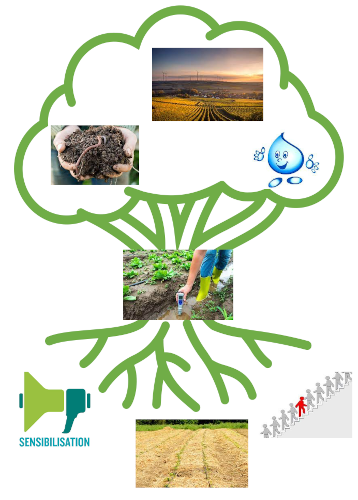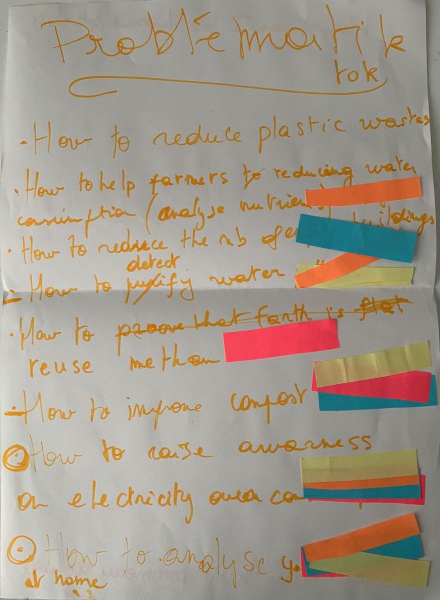5. Teams dynamique and final project.#
This section can be divided into 3 parts: 1. the problem and solution tree 2. the formation of the group and the problematic 3. group dynamics
Problem and solution tree#
For this module, we needed to create a problem and solution tree with problematics coming from the projects of last year and Frugal science projects that were presented in class. With my partner, we chose the problematic : “waste and overconsumption of water in agricultural activities”. Indeed, around 70% of global water consumption is spent on agriculture. A large part of it is lost because it is not used by the plants. We therefore encounter a major problem of waste.
But before we present our trees to you, we must understand the concept behind them. These are tools that first allow us to analyze a problem and understand its causes and consequences with the problem tree. Then with the solution tree, we want to find the objective to tackle the problematic. We then replace the causes for the activities to be implemented and the consequences with the outcomes. This tool is powerful because the roots and branches divide and merge, we can therefore notice the entanglement of causes and consequences. We will use these again during the team project.
We divided the roots and branches into 2 categories each time. For the roots we have the causes first and the causes behind it which are the deep roots. For the branches have the consequences and the ramifications of these are the side effects. All information is included in the tables below with the trees.
Problem tree#


Soltution tree#


When making the trees, we misunderstood the instructions and we thought that we couldn’t put words in the tree and only images for understanding. Now I realize that we made a mistake and that we could have added text. The pictures really make the trees difficult to understand and leave too much interpretation. Sorry for your eyes …
group formation and problematic#
The kickoff was spread over 2 days. On the first one, Etienne came to introduce us to “la boutique des sciences” and what it involves. The primary goal is to connect citizens with scientists to resolve problems encountered in everyday life. On the second day, we had the introductory session on the group project. The previous day, we were instructed to bring an object related to an issue/problematic that is important to us. My object was a book on architecture to represent the empty buildings in Brussels (even if it is not really related) I have always been interested in architecture and with this interest I discovered the problem of empty/abandoned buildings in big cities. In the case of Brussels, all these buildings grouped together have the size of the municipality which is named “St Vide” and represents 6.8 million m2.
Firstly, we all placed our objects on the ground and we were able to observe them without talking. Then we discussed the objects between us. I immediately went to speak about objects that I didn’t understand. Our group was formed randomly because there were just 4 of us even though we didn’t really have anything in common between us. Our group is therefore composed of Ana, Lukas, Jean. Once we made the groups, we brainstormed together and talked a bit about our object. We tried to identify some common points that could lead us to our problematic. This is were we struggle a lot because our group was formed randomly and there was almost no link between our objects. Another added difficulty is the fact that our problematic and solution must be in the theme of making the invisible visible At the end of the day we had a lot of solution which was a problem because we needed problematics and so in the end we had to start from scratch the next week.
problematics (aka solutions) we found#

Group dynamics#
When the group was formed, we made a charter with the rules to respect between us. We also adopted some teamwork techniques and assigned each person’s roles.
the charter :#
 You can also see the role we assigned to each other. We decided to wait a week to see if the roles suited us or if we needed to do a rotation. In the end we decided to keep the same role for the entire project while helping each other along the way.
You can also see the role we assigned to each other. We decided to wait a week to see if the roles suited us or if we needed to do a rotation. In the end we decided to keep the same role for the entire project while helping each other along the way.
team work techniques#
-
The weather/highlights : In our group we did another version af the weather called Highlights. It consists of saying a good moment that happened this week or that will happen in the days to come to be in a good mood from the start of our meetings
-
Decision system: we use the consensus method, which consists of making a decision only if no one is opposed to it. Which improved efficiency unlike a method where everyone needs to agree to make a decision
-
Assigned roles: this technique prevents one person from being just a spectator during the meetings. We can therefore distribute tasks well and be as efficient as possible in meetings. Roles can be in rotation or assigned depending on the group. The roles are:
- The host: leads the meeting and makes sure everyone gets to talk. (=Lukas)
- The secretary (=me): takes notes on what is said during the meeting
- The time manager (=Ana): keeps an eye on the clock to make sure the meeting is moving at the right pace, and and check that all points have been covered
-
The “atmosphere” (=Jean): ensures that meetings go well
-
Distribution of speech: several possibilities exist but from experience we decided to just avoid interrupting the speech of others